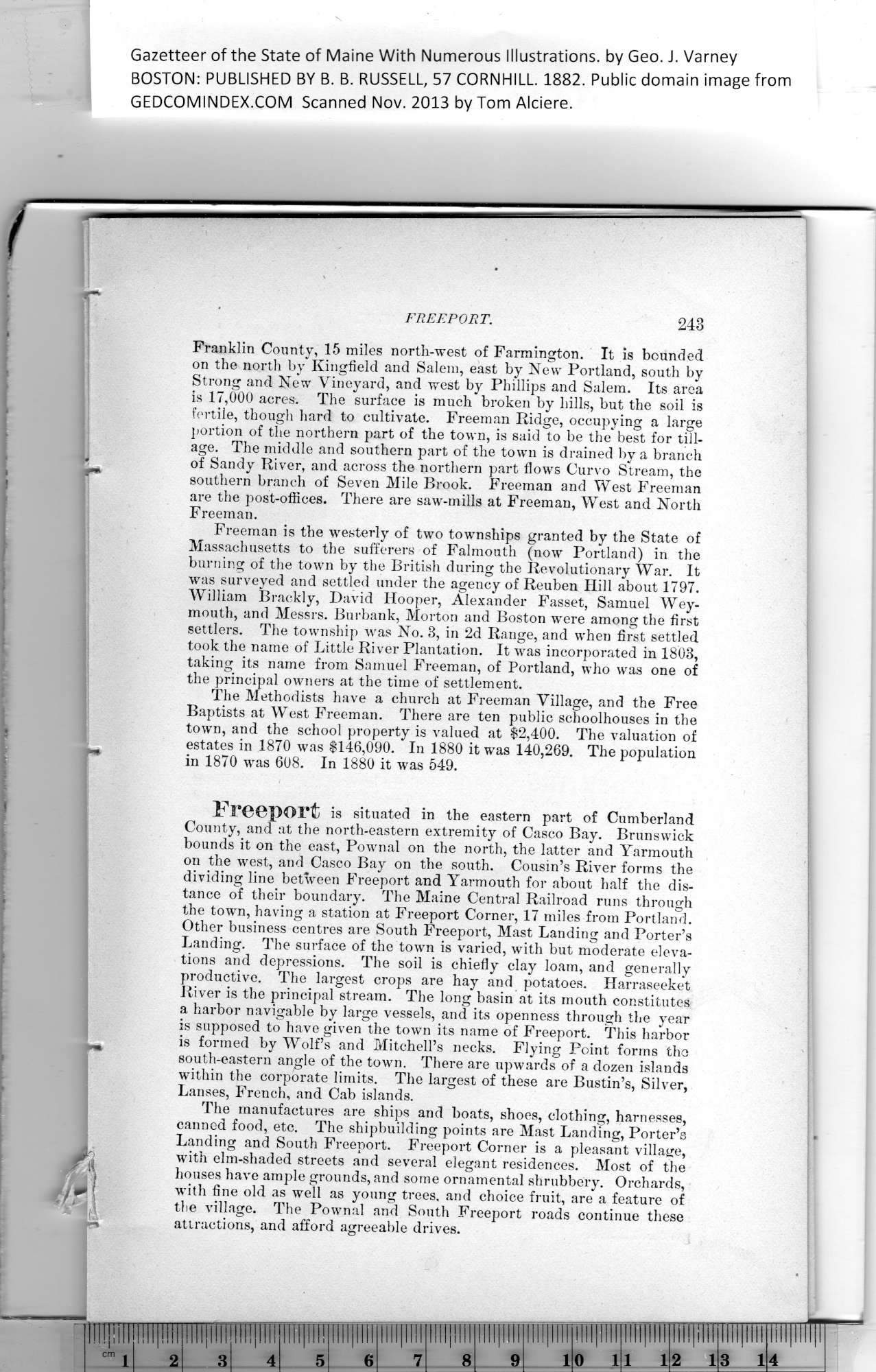|
Gazetteer of the State of Maine With Numerous Illustrations, by Geo. J. Varney
BOSTON: PUBLISHED BY B. B. RUSSELL, 57 CORNHILL. 1882. Public domain image from
fP*
FREEPORT.
Franklin County, 15 miles north-west of Farmington. It is bounded
on the north by Kingfield and Salem, east by New Portland, south by
Strong and New Vineyard, and west by Phillips and Salem. Its area
is 17,000 acres. The surface is much broken by bills, but the soil is
fertile, though hard to cultivate. Freeman Ridge, occupying a large
portion of the northern part of the town, is said to be the best for till-
age. The middle and southern part of the town is drained by a branch
of Sandy River, and across the northern part flows Curvo Stream, the
southern branch of Seven Mile Brook. Freeman and West Freeman
are the post-offices. There are saw-mills at Freeman, West and North
Freeman.
Freeman is the westerly of two townships granted by the State of
Massachusetts to the sufferers of Falmouth (now Portland) in the
burning of the town by the British during the Revolutionary War. It
was surveyed and settled under the agency of Reuben Hill about 1797.
William Brackly, David Hooper, Alexander Fasset, Samuel Wey-
mouth, and Messrs. Burbank, Morton and Boston were among the first
settlers. The township was No. 3, in 2d Range, and when first settled
took the name of Little River Plantation. It was incorporated in 1803,
taking its name from Samuel Freeman, of Portland, who was one of
the principal owners at the time of settlement.
The Methodists have a church at Freeman Village, and the Free
Baptists at West Freeman. There are ten public schoolhouses in the
town, and the school property is valued at $2,400. The valuation of
estates in 1870 wras $146,090. In 1880 it was 140,269. The population
in 1870 was 608. In 1880 it was 549.
Freeport is situated in the eastern part of Cumberland
County, and at the north-eastern extremity of Casco Bay. Brunswick
bounds it on the east, Pownal on the north, the latter and Yarmouth
on the west, and Casco Bay on the south. Cousin’s River forms the
dividing line between Freeport and Yarmouth for about half the dis-
tance of their boundary. The Maine Central Railroad runs through
the town, having a station at Freeport Corner, 17 miles from Portland.
Other business centres are South Freeport, Mast Landing and Porter’s
Landing. The surface of the town is varied, with but moderate eleva-
tions and depressions. The soil is chiefly clay loam, and generally
productive. The largest crops are hay and potatoes. Harraseeket
River is the principal stream. The long basin at its mouth constitutes
a harbor navigable by large vessels, and its openness through the year
is supposed to have given the town its name of Freeport. This harbor
is formed by Wolf’s and Mitchell’s necks. Flying Point forms the
south-eastern angle of the town. There are upwards of a dozen islands
within the corporate limits. The largest of these are Bustin’s, Silver,
Lanses, French, and Cab islands.
The manufactures are ships and boats, shoes, clothing, harnesses,
canned food, etc. The shipbuilding points are Mast Landing, Porter’s
Landing and South Freeport. Freeport Corner is a pleasant village,
with elm-shaded streets and several elegant residences. Most of the
houses have ample grounds, and some ornamental shrubbery. Orchards,
with fine old as well as young trees, and choice fruit, are a feature of
the village. The Pownal and South Freeport roads continue these
attractions, and afford agreeable drives.
PREVIOUS PAGE ... NEXT PAGE
This page was written in HTML using a program written in Python 3.2
|
